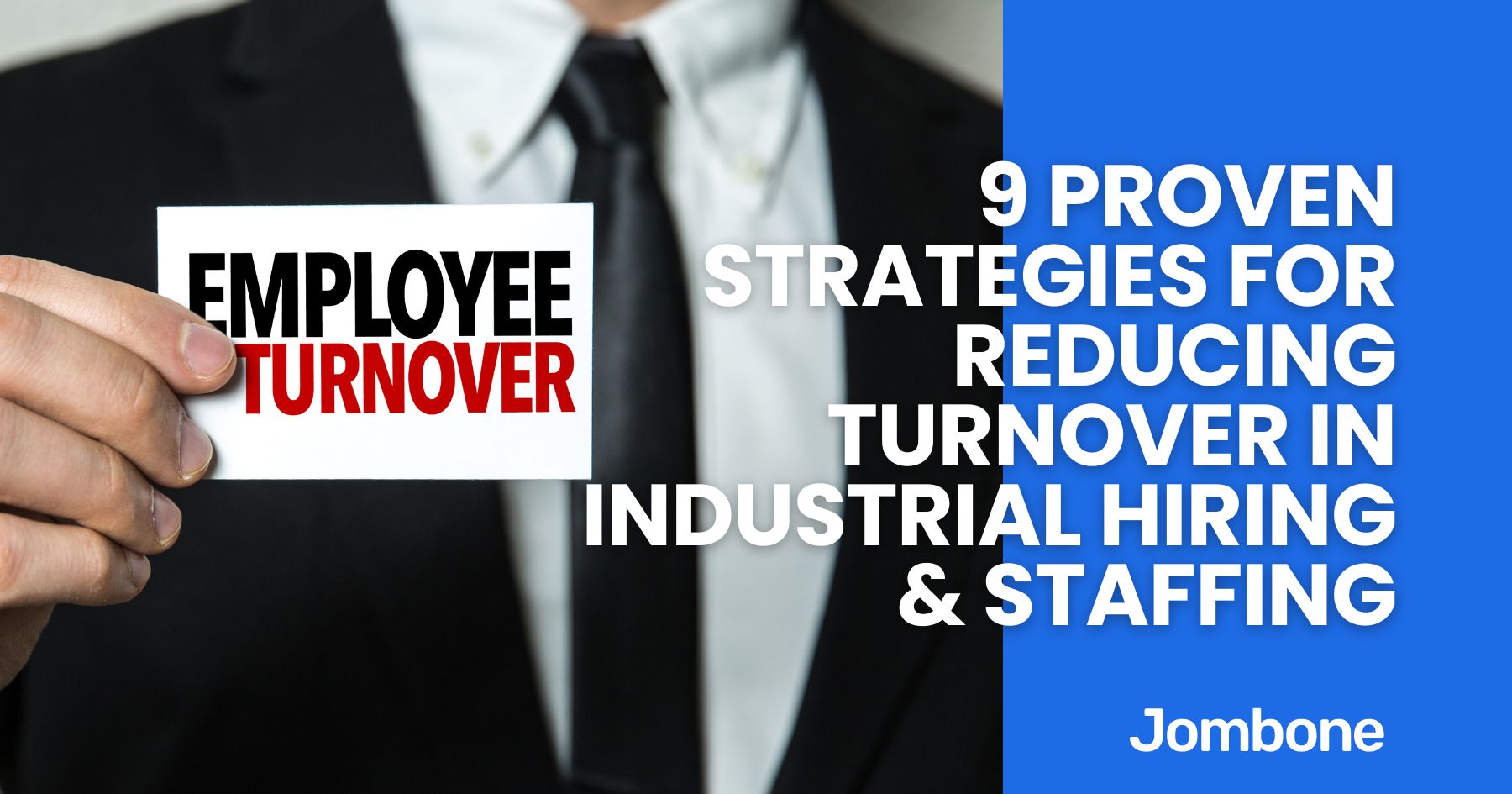Did you know that the industrial sector experiences one of the highest employee turnover rates across all industries? This constant churn not only leads to increased costs but also disrupts operations, delaying projects and affecting overall productivity. To address this issue, companies need to implement effective strategies that attract and retain skilled workers. Here are nine strategies that can help minimize turnover in industrial hiring and staffing.
1. Streamlined Recruitment Process
Simplifying the application and hiring process can make a huge difference in attracting top talent. A complicated process can deter potential candidates, especially when better opportunities are just a click away. Here’s how to streamline recruitment:
- Digital Application: Let candidates apply online using an easy-to-use platform that supports digital candidate work profiles like Jombone. This saves time for both the candidate and the recruiter.
- Video Interviews: Use video calls instead of face-to-face interviews. This can save time, money, and make it easier for candidates who may not live nearby.
- Flexible Interview Scheduling: Offer flexible times for interviews. This helps candidates fit the interview into their busy schedules.
These steps not only modernize the recruitment process but also make it more convenient for candidates, thereby enhancing their experience from the get-go along with job matching and finding the right fit for the right job.
2. Competitive Pay and Overtime Opportunities
In blue-collar work, having competitive pay is crucial. Offering wages that meet or go beyond industry standards can keep workers from looking elsewhere. Here’s why competitive pay and overtime opportunities are essential:
- Attracting Talent: Competitive pay ensures you attract skilled and experienced workers who might otherwise choose another employer offering better wages.
- Retention: Fair pay keeps employees satisfied and reduces the likelihood of them seeking employment elsewhere.
- Overtime Opportunities: Offering overtime allows workers to increase their earnings. Many industrial workers rely on overtime to boost their income, which can make your company more attractive.
- Transparent Pay Structure: Ensure that your pay structure is clear and understandable. Employees appreciate transparency and will trust a company that is straightforward about compensation.
3. Safety Training and Compliance
Safety at work is extremely important, especially in industrial settings where hazards are common. Focusing on safety training and compliance shows that the company cares about its workers’ well-being. Here’s how to prioritize safety:
- Regular Safety Drills: Conduct regular safety drills to ensure all employees know what to do in case of an emergency.
- Up-to-Date Equipment: Make sure all equipment is regularly maintained and updated to meet safety standards.
- Safety Protocols: Implement and enforce strict safety protocols. Ensure that all workers are trained on these protocols during their onboarding and through regular refreshers.
- Compliance with Regulations: Stay up to date with local and national safety regulations. Compliance not only protects workers but also shields the company from legal issues.
- Safety Culture: Promote a culture where safety is a priority. Encourage employees to report hazards and take proactive steps to maintain a safe working environment.
4. Shift Flexibility
Strict shift schedules can be a problem for workers with personal commitments. Offering flexible shift schedules helps workers balance their job with other responsibilities. Here’s why shift flexibility is important:
- Work-Life Balance: Flexible shifts help employees manage their work-life balance, reducing stress and burnout.
- Greater Job Satisfaction: Employees who have control over their schedules are often more satisfied with their jobs.
- Reduced Absenteeism: Flexibility can lead to lower absenteeism rates as employees are better able to manage their personal responsibilities.
- Attracting Diverse Talent: Flexible scheduling can attract a more diverse workforce, including parents, students, and those with other commitments.
5. Performance-Based Incentives
Giving performance-based incentives is a great way to motivate employees. Here’s how to effectively implement performance-based incentives:
- Bonuses: Offer financial bonuses for meeting production targets, maintaining perfect attendance, or adhering to safety standards.
- Recognition Programs: Publicly recognize employees who excel in their roles. This can be through awards, certificates, or special mentions in company meetings or newsletters.
- Career Progression: Link incentives to career development opportunities. Employees who see a clear path for progression are more likely to stay with the company.
- Non-Monetary Rewards: Consider non-monetary rewards such as additional paid time off, gift cards, or other perks. Sometimes, these can be just as motivating as cash bonuses.
6. Accessible Training and Skill Development
Personal and professional growth opportunities are crucial for employee retention. Here’s how to make training and skill development accessible:
- On-the-Job Training: Offer hands-on training that allows employees to learn while they work. This can be particularly effective in industrial settings where practical skills are essential.
- Workshops and Seminars: Regularly schedule workshops and seminars that focus on skill enhancement and industry advancements.
- Online Training Resources: Provide access to online videos and resources that employees can use at their own pace. This flexibility makes it easier for workers to improve their skills without interfering with their job.
- Certification Programs: Support employees in obtaining industry certifications. This not only improves their skills but also increases their value to the company.
- Mentorship: Establish mentorship programs where experienced employees can guide newer ones, fostering a culture of continuous learning and support.
7. Supportive Supervision
The quality of supervision can significantly impact the work environment. Here’s how to ensure supervision is supportive:
- Leadership Training: Train supervisors to provide supportive and respectful leadership. This includes communication skills, conflict resolution, and motivational techniques.
- Open Communication: Encourage a culture of open communication where employees feel comfortable voicing their concerns and ideas.
- Guidance and Feedback: Provide regular feedback and guidance. Constructive criticism should be delivered in a way that encourages improvement rather than discouragement.
- Address Concerns Promptly: Ensure supervisors address any concerns or issues promptly. Ignoring problems can lead to dissatisfaction and higher turnover.
- Empathy and Respect: Supervisors should treat all employees with empathy and respect, recognizing their contributions and valuing their input.
8. Employee Assistance Programs
Personal and work-related challenges can affect an employee’s performance and decision to stay with a company. Providing employee assistance programs (EAPs) can offer the support workers need to manage these challenges. Here’s how to implement EAPs effectively:
- Counseling Services: Offer access to counseling services for employees dealing with personal or work-related stress.
- Financial Advice: Provide resources for financial planning and advice, helping employees manage their finances more effectively.
- Stress Management: Include stress management programs that help employees cope with workplace pressures.
- Health and Wellness: Promote health and wellness programs that encourage a healthy lifestyle, such as fitness memberships, smoking cessation programs, or nutritional advice.
- Confidential Support: Ensure that all support services are confidential, making employees feel safe and secure in seeking help.
9. Proactive Workforce Engagement
Active engagement with your workforce can significantly enhance job satisfaction and retention. Here’s how to engage your workforce proactively:
- HR Activities: Organize regular HR activities like team-building exercises, which can help workers feel connected and included.
- Team Building Events: Plan team outings, lunches, and social events to build relationships outside the workplace.
- Proactive Communication: Maintain open lines of communication between HR and employees. Regular check-ins, surveys, and feedback sessions can help address concerns before they escalate.
- Employee Recognition: Celebrate milestones and achievements, both big and small, to make employees feel valued and appreciated.
- Wellness Initiatives: Incorporate wellness initiatives like fitness challenges, mental health awareness programs, and healthy eating campaigns to promote a holistic approach to well-being.
By implementing these strategies, industrial companies can create a more attractive and supportive work environment, leading to reduced turnover and enhanced productivity. Investing in your workforce through competitive pay, flexible scheduling, safety training, and supportive supervision can build long-term loyalty and ensure a steady, skilled workforce.

